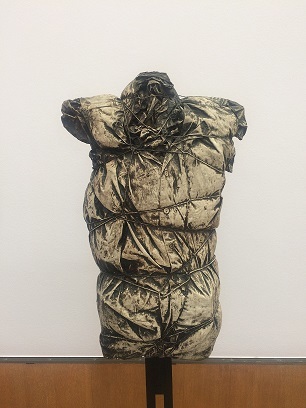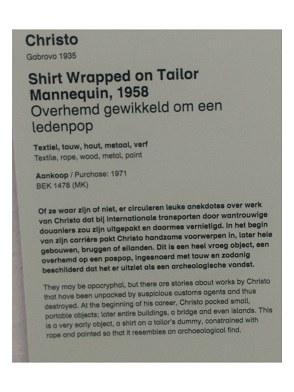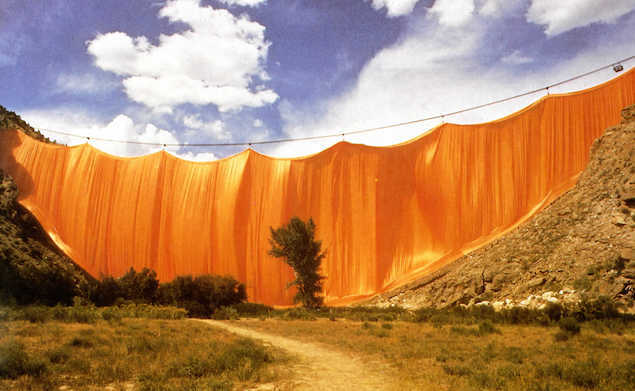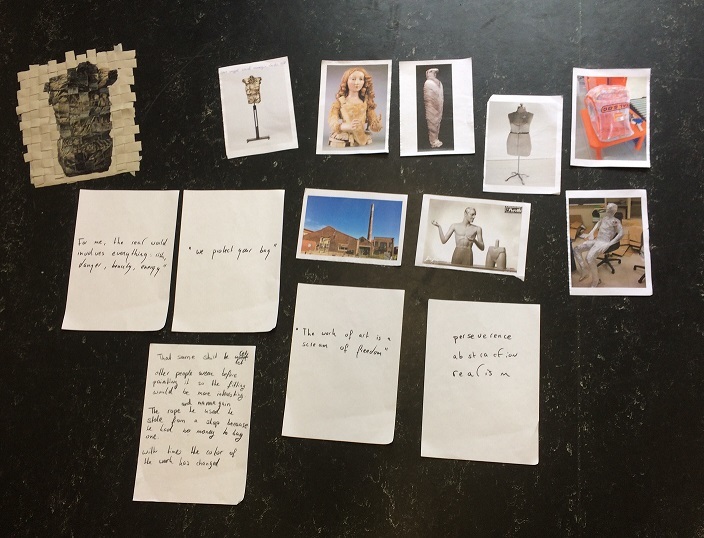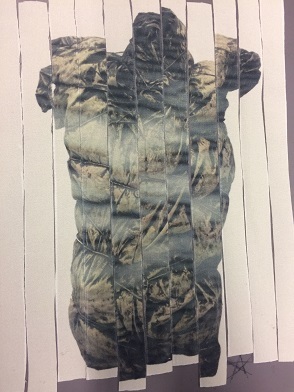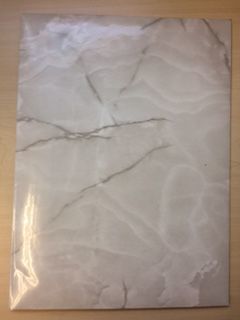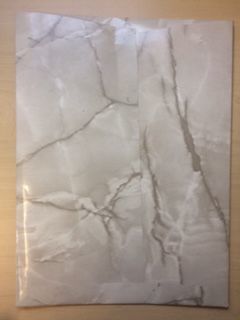Difference between revisions of "User:Andres Matos"
| (40 intermediate revisions by the same user not shown) | |||
| Line 1: | Line 1: | ||
| − | Welcome to my page | + | ===Welcome to my page=== |
| + | |||
| + | ---- | ||
| + | |||
| + | =====Introduction===== | ||
| + | |||
| + | CHRISTO | ||
| + | |||
| + | Christo Vladimirov Javacheff and Jeanne-Claude were a married couple who created huge instillations of artwork and worked with the environment as their canvas. Coincidentially Christo and Jeanne share the same date of birth , June 13, 1935; Christo in Gabrovo, Bulgaria, and Jeanne-Claude in Morocco. They first met in Paris in October 1958 during and portrait session of Christo where he painted Jeanne-Claude's mother. Romantically falling in love while making art together. | ||
| + | |||
| + | Their trademark is using the wrap technique to wrap all sorts of things, from objects like a mannequin to buildings and islands, enhancing the beauty of the silhouet of an object. Their works include the wrapping of the Reichstag in Berlin and the Pont-Neuf bridge in Paris, the 24-mile (39 km)-long artwork called Running Fence in Sonoma and Marin counties in California, and The Gates in New York City's Central Park. | ||
| + | |||
| + | Credit was given to "Christo" only, until 1994, when the outdoor works and large indoor installations were retroactively credited to "Christo and Jeanne-Claude." They flew in separate planes: in case one crashed, the other could continue their work. | ||
| + | |||
| + | Jeanne-Claude died, aged 74, on November 18, 2009, from complications of a brain aneurysm. | ||
| + | |||
| + | =====Although their work is visually impressive and often controversial as a result of its scale, the artists have repeatedly denied that their projects contain any deeper meaning than their immediate aesthetic impact. The purpose of their art, they contend, is simply to create works of art for joy and beauty and to create new ways of seeing familiar landscapes.===== | ||
| + | Art critic David Bourdon has described Christo's wrappings as a "revelation through concealment."[3] To his critics Christo replies, "I am an artist, and I have to have courage ... Do you know that I don't have any artworks that exist? They all go away when they're finished. Only the preparatory drawings, and collages are left, giving my works an almost legendary character. I think it takes much greater courage to create things to be gone than to create things that will remain."[4] | ||
| + | |||
| + | |||
| + | |||
| + | '''Sources''' | ||
| + | |||
| + | ''1'' Jump up to: a b c d e Grimes, William (November 19, 2009). "Jeanne-Claude, Collaborator With Christo, Dies at 74". The New York Times. Retrieved November 20, 2009. | ||
| + | |||
| + | ''2'' Jump up to: a b Miller, Stephen; Crow, Kelly (November 20, 2009). "Part of a Creative Powerhouse Behind Ephemeral Artworks". The Wall Street Journal. Dow Jones. Retrieved November 20, 2009. | ||
| + | |||
| + | ''3'' Bourdon, David: "Christo", Harry N. Abrams Publishers, Inc., New York City, 1970. | ||
| + | |||
| + | ''4'' Living with Art, Mark Getlein | ||
| + | |||
| + | |||
| + | ---- | ||
| + | ==Artefact== | ||
| + | |||
| + | |||
| + | [[File:Shirt Wrapped Around Mannequin, Christo, 1958.JPG]] | ||
| + | [[File:Shirt Wrapped Around Mannequin, Christo, 1958 (2).JPG]] | ||
| + | |||
| + | =====Shirt wrapped around mannequin, Christo, 1958===== | ||
| + | |||
| + | I was immediately inspired by this artefact because it gave me ideas of how I can make a translation of it into the context of fashion. So my inspiration was in first instance from a more practical point of view. After diving into the artists and their work it started giving me more appreciation of the work , not just for its artistic values and qualities but also to be able to manage to wrap those huge objects from textiles and also to maintain its beauty for a certain amount of time is admirable and a huge task. | ||
| + | |||
| + | |||
| + | |||
| + | |||
| + | [[File:CHRISTO007.jpg]] | ||
| + | |||
| + | =====The Library, Christo, Rizzoli New York, Books, Marina Vaizey, Published 1990===== | ||
| + | |||
| + | ---- | ||
| + | |||
| + | ==Visual Presentation== | ||
| − | |||
[[File:Visual_presentation_2.jpeg]] | [[File:Visual_presentation_2.jpeg]] | ||
| + | <gallery> | ||
| + | File:6c0bb3ca0e921f001a5383e941cf1a87--daguerreotype-deep-space.jpg | ||
| + | File:7a21d45b86a2c4db19dbd811c17f1cbb.jpg | ||
| + | File:1950s-vintage-acme-adjustable-size-c-dress-form 2.jpg | ||
| + | File:62d9f4aea05bded23cf33cba20b76d1a.jpg | ||
| + | File:De7dafcae294cd928329bd647e590472.jpg | ||
| + | File:Sealed Kinderzitje-225x300.jpg | ||
| + | File:3699fda82edfc7bdc474f2e6d8bbf5d8.jpg | ||
| + | File:3447775613 1d4534d321 b.jpg | ||
| + | File:09 carine roitfeld Dior Couture book Fantastic World demarchelier.jpg | ||
| + | File:A8374391c16b34e2fdb2eba525dbb1fd.jpg | ||
| + | </gallery> | ||
| + | |||
| + | These are the images based on the assignment of choosing pictures, making up a lie, and writing down interesting quotes about the artefact. | ||
| + | The images that you see are: | ||
| + | * Images of mannequins of the time the artefact was made, and historic ones. | ||
| + | * A historic example of wrapping ( a mummy) | ||
| + | * A contemporary exampe of wrapping (sealing baggage at the airport) and wrapping tape around the body. | ||
| + | * Images of what people wore in the time the artefact was made. | ||
| + | |||
| + | =====Ideas===== | ||
| + | |||
| + | My different ideas to appropriete from were: | ||
| + | |||
| + | =====What if the paint he used was done with an airbrush or graffiti.===== | ||
| + | The garment used was a sweater instead of a mens shirt and a cable (smartphone charger) instead of a rope? By doing this I would be using a more contemporary medium to give the artefact a different meaning. The easthetic would be more street and new instead of antique and historic. | ||
| + | |||
| + | =====What if there were’nt mannequins?===== | ||
| + | |||
| + | =====What if the artefact was litteraly kopied and printed onto a fabric as an image===== | ||
| + | To make it 2d instead of 3d. By doing this I would be using the printer as a newer technologie. After this I could use the printed image to make another form of it. This way the context of the artefact would be different. | ||
| + | |||
| + | |||
| + | [[File:Shirt printed with sublimation printer.JPG]] [[File:Shirt printed with sublimation printer (2).JPG]] | ||
| + | |||
| + | =====What if this artefact (shirt wrapped around mannequin, Christo, 1958) was actually made into a garment?===== | ||
| + | I wanted to make a garment by using the wrapping technique as inspiration but using other material to give it another meaning. I wanted it to put the artefact in a sensual context, because the wrapping with rope around the artefact gave me a sensual connotation. It reminded me of asanawa (麻縄), Japanese bondage. Also since the artefact is quite messy and chaotic, I was curious what would happen if I soften it as a contrast. | ||
| + | * How can I translate this connotation to a garment? | ||
| + | * What is a sensual material that I can use to make the garment? | ||
| + | My first idea for sensual material was a sheer material, for example lingerie. That got me thinking that there isn’t really lingerie for men so, what if I use women's lingerie as inspiration to make men’s lingerie, or simply use womens lingerie as inspiration to make mens clothes to give it a sensual meaning. I think that this idea, to make the mens contemporary image more softer and sensual, is a contemporary idea. Specially when you look at the cultural changes that are happening. Women are rising to the top and the stereotypical image and role of the men has been challenged more and more especially the past few years. So I thought this could be interesting. | ||
| + | |||
| + | The first and the last lie speak to me the most. Since I allready choose the last one I’m sticking to that but I'm curious how the first lie would turn out. In the last lie there isn’t really new technologie included(if you dont include the technologie that has been used to knit the panty) so I have to see how I can incorperate this into the piece. However I'm curious about the possibilities. Therefore I'm making a serie to discover the possibilities of the wrapping technique. | ||
| + | |||
| + | ---- | ||
| + | ==Speculative Future== | ||
| + | |||
| + | =====Speculative Future===== | ||
| + | |||
| + | [[File:900x450 131587.jpg]] | ||
| + | |||
| + | Badboot, Wieki Somers, Studio Wieki Somers, 't Vliehout (in 2005) | ||
| + | |||
| + | Since there is a contradiction in this artwork, I thought about going on this idea. I wanted to make a boat that you can fold like origami so its easier to cary in the future. However the material doesn't exist that can offer a DIY construction to fold and carry people on it. So the boat becomes useless. | ||
| + | |||
| + | <gallery> | ||
| + | File:Boat reconstruction.JPG | ||
| + | File:Boat reconstruction 3.JPG | ||
| + | File:IMG 8271.JPG | ||
| + | File:IMG 8272.JPG | ||
| + | File:Boat reconstruction 4.JPG | ||
| + | File:Boat reconstruction 5.JPG | ||
| + | File:IMG 8197.JPG | ||
| + | </gallery> | ||
| + | |||
| + | ---- | ||
| + | ==Contrafactual Past== | ||
| + | |||
| + | =====Proces===== | ||
| + | |||
| + | The idea with this was, what if there werent any telephones? People would still communicate with letters. So what if instead of paper the letters were made from concrete? Why? Because it's impossible and also quite funny, just like Dali's. | ||
| + | |||
| + | <gallery> | ||
| + | File:Lobster-Aphrodisiac-Telephone-Salvador-Dali.jpg | ||
| + | </gallery> | ||
| + | |||
| + | [[File:IMG 8273.JPG]] | ||
| + | [[File:IMG 8274.JPG]] | ||
| + | |||
| + | |||
| + | ---- | ||
| + | |||
| + | |||
| + | ==Copy Artefact== | ||
| + | |||
| + | =====Proces===== | ||
| + | |||
| + | <gallery mode'> | ||
| + | File:Shirt.JPG | ||
| + | File:Shirt Wrapped With Coffee.JPG | ||
| + | File:Fiber Fill as base.JPG | ||
| + | File:Copy front.JPG | ||
| + | File:Copy Side.JPG | ||
| + | File:IMG 8246.JPG | ||
| + | File:Copy Back.JPG | ||
| + | File:IMG 8249.JPG | ||
| + | </gallery> | ||
| + | |||
| + | What I did to make the copy of the artefact was: | ||
| + | * Pour coffee over the shirt and wrap it in rope. After that put it in a bowl and in the oven for a couple of hours. | ||
| + | * Use fiberfill and wrap it around a mannequin | ||
| + | * Put the shirt over the fiberfill and button it up. | ||
| + | * Use elastic, rope and yarn to wrap it around the shirt. I used different types of rope and elastic to create a dynamic composition. | ||
| + | |||
| + | ---- | ||
| + | |||
| + | ==Contemporary Prototype== | ||
| + | |||
| + | =====Proces===== | ||
| + | <gallery mode'> | ||
| + | File:IMG 8214.JPG | ||
| + | File:IMG 8219.JPG | ||
| + | File:IMG 8226.JPG | ||
| + | File:IMG 8228.JPG | ||
| + | File:IMG 8229.JPG | ||
| + | File:Moulage arm.JPG | ||
| + | File:Moulage arm side.JPG | ||
| + | File:Moulage Back.JPG | ||
| + | File:Shirt Front.JPG | ||
| + | File:Shirt Back.JPG | ||
| + | File:IMG 8241.JPG | ||
| + | File:IMG 8242.JPG | ||
| + | File:Shirt Back II.JPG | ||
| + | </gallery> | ||
| + | |||
| + | When I started making the Contemporary Prototype I first cut multiple panties and sewed them together. When I had a long stroke, I started playing with it and wrapping it around the body like Christo did. I also tried to wrap it more controlled like the Egyptians did. My goal was to make a garment that had or the sensual qualities of lingerie or try to translate the artistic qualities of a Christo into an interesting garment. I also tried a knotting technique to make a sleeve out of it. The idea could be used to make a shirt or jacket with those sleeves. When I finished the sleeve I started another idea. Also I wanted to discover the possibilities of a panty. This by trying different techniques and ways of making a garment. This way there would be a more linear process. | ||
| + | |||
| + | Then I started to sew the panties horizontally together to create like a fabric. When I had a big piece I started to wrap it around the body. In first hand I had the seemside inside of the garment, but I decided to switch the inside with the outside of the garment because it gives more dept to the garment, otherwise it would be quite flat. And since the garment is quite tight I thought that this effect would give the garment an extra dimension. The lines on the front are horizontally and on the back vertically. | ||
| + | |||
| + | Is it lingerie yet? No I dont think so. To make it more lingerie and sensual, next time I would like to enhance the male body more. This means play more with the lines for example on the sleeve horizontal to make the body look more broad. And the lines in the middle vertical, with a darker tone on the sides so it would create an illusion that the waist area is slimmer to create a V-body shape. Also to play more with the arms, shoulder and back area, since this are good areas to play with because shoulders arms and back symbolize for strength. I would like to create forms with the sheer material on those areas. Also play more with colors, like adding black, red, and blue. I do like the material, also when you wear it, it gives an image that the skin is very soft and smooth. | ||
| + | |||
| + | ---- | ||
| + | |||
| + | =====Styling===== | ||
| + | |||
| + | To style the look I got inspiration from the garments people wore at that time. I hoped that this would bring my whole research together. So a mens colbert, and a shirt but changed into a korset. | ||
| + | |||
| + | <gallery> | ||
| + | File:De7dafcae294cd928329bd647e590472.jpg | ||
| + | File:09 carine roitfeld Dior Couture book Fantastic World demarchelier.jpg | ||
| + | File:A8374391c16b34e2fdb2eba525dbb1fd.jpg | ||
| + | File:62d9f4aea05bded23cf33cba20b76d1a.jpg | ||
| + | </gallery> | ||
| + | |||
| + | ---- | ||
| + | |||
| + | =====Result===== | ||
| + | |||
| + | The result is a men wrapped around garments inspired by womenswear and womenslingerie. | ||
| + | |||
| + | <gallery> | ||
| + | File:IMG 8254.JPG | ||
| + | File:IMG 8255.JPG | ||
| + | File:IMG 8256.JPG | ||
| + | </gallery> | ||
| − | + | ---- | |
| − | + | =====Blueprint===== | |
| − | |||
| − | + | This is how I envision the look to be once completed. The whole body coverd in a catsuit of panties and styled with a korset and a pleated pantalon inspired by the clothing of the 1950's. | |
| − | + | <gallery> | |
| + | File:Blueprint Design Front.JPG | ||
| + | File:IMG 8269.JPG | ||
| + | File:IMG 8270.JPG | ||
| + | </gallery> | ||
| − | + | ---- | |
| − | + | =====Presentation===== | |
| + | <gallery> | ||
| + | File:IMG 8252.JPG | ||
| + | File:IMG 8253.JPG | ||
| + | File:IMG 8266.JPG | ||
| + | </gallery> | ||
Latest revision as of 21:23, 14 May 2020
Contents
- 1 Welcome to my page
- 1.1 Introduction
- 1.2 Although their work is visually impressive and often controversial as a result of its scale, the artists have repeatedly denied that their projects contain any deeper meaning than their immediate aesthetic impact. The purpose of their art, they contend, is simply to create works of art for joy and beauty and to create new ways of seeing familiar landscapes.
- 2 Artefact
- 3 Visual Presentation
- 3.1 Ideas
- 3.2 What if the paint he used was done with an airbrush or graffiti.
- 3.3 What if there were’nt mannequins?
- 3.4 What if the artefact was litteraly kopied and printed onto a fabric as an image
- 3.5 What if this artefact (shirt wrapped around mannequin, Christo, 1958) was actually made into a garment?
- 4 Speculative Future
- 5 Contrafactual Past
- 6 Copy Artefact
- 7 Contemporary Prototype
Welcome to my page
Introduction
CHRISTO
Christo Vladimirov Javacheff and Jeanne-Claude were a married couple who created huge instillations of artwork and worked with the environment as their canvas. Coincidentially Christo and Jeanne share the same date of birth , June 13, 1935; Christo in Gabrovo, Bulgaria, and Jeanne-Claude in Morocco. They first met in Paris in October 1958 during and portrait session of Christo where he painted Jeanne-Claude's mother. Romantically falling in love while making art together.
Their trademark is using the wrap technique to wrap all sorts of things, from objects like a mannequin to buildings and islands, enhancing the beauty of the silhouet of an object. Their works include the wrapping of the Reichstag in Berlin and the Pont-Neuf bridge in Paris, the 24-mile (39 km)-long artwork called Running Fence in Sonoma and Marin counties in California, and The Gates in New York City's Central Park.
Credit was given to "Christo" only, until 1994, when the outdoor works and large indoor installations were retroactively credited to "Christo and Jeanne-Claude." They flew in separate planes: in case one crashed, the other could continue their work.
Jeanne-Claude died, aged 74, on November 18, 2009, from complications of a brain aneurysm.
Although their work is visually impressive and often controversial as a result of its scale, the artists have repeatedly denied that their projects contain any deeper meaning than their immediate aesthetic impact. The purpose of their art, they contend, is simply to create works of art for joy and beauty and to create new ways of seeing familiar landscapes.
Art critic David Bourdon has described Christo's wrappings as a "revelation through concealment."[3] To his critics Christo replies, "I am an artist, and I have to have courage ... Do you know that I don't have any artworks that exist? They all go away when they're finished. Only the preparatory drawings, and collages are left, giving my works an almost legendary character. I think it takes much greater courage to create things to be gone than to create things that will remain."[4]
Sources
1 Jump up to: a b c d e Grimes, William (November 19, 2009). "Jeanne-Claude, Collaborator With Christo, Dies at 74". The New York Times. Retrieved November 20, 2009.
2 Jump up to: a b Miller, Stephen; Crow, Kelly (November 20, 2009). "Part of a Creative Powerhouse Behind Ephemeral Artworks". The Wall Street Journal. Dow Jones. Retrieved November 20, 2009.
3 Bourdon, David: "Christo", Harry N. Abrams Publishers, Inc., New York City, 1970.
4 Living with Art, Mark Getlein
Artefact
Shirt wrapped around mannequin, Christo, 1958
I was immediately inspired by this artefact because it gave me ideas of how I can make a translation of it into the context of fashion. So my inspiration was in first instance from a more practical point of view. After diving into the artists and their work it started giving me more appreciation of the work , not just for its artistic values and qualities but also to be able to manage to wrap those huge objects from textiles and also to maintain its beauty for a certain amount of time is admirable and a huge task.
The Library, Christo, Rizzoli New York, Books, Marina Vaizey, Published 1990
Visual Presentation
These are the images based on the assignment of choosing pictures, making up a lie, and writing down interesting quotes about the artefact. The images that you see are:
- Images of mannequins of the time the artefact was made, and historic ones.
- A historic example of wrapping ( a mummy)
- A contemporary exampe of wrapping (sealing baggage at the airport) and wrapping tape around the body.
- Images of what people wore in the time the artefact was made.
Ideas
My different ideas to appropriete from were:
What if the paint he used was done with an airbrush or graffiti.
The garment used was a sweater instead of a mens shirt and a cable (smartphone charger) instead of a rope? By doing this I would be using a more contemporary medium to give the artefact a different meaning. The easthetic would be more street and new instead of antique and historic.
What if there were’nt mannequins?
What if the artefact was litteraly kopied and printed onto a fabric as an image
To make it 2d instead of 3d. By doing this I would be using the printer as a newer technologie. After this I could use the printed image to make another form of it. This way the context of the artefact would be different.
What if this artefact (shirt wrapped around mannequin, Christo, 1958) was actually made into a garment?
I wanted to make a garment by using the wrapping technique as inspiration but using other material to give it another meaning. I wanted it to put the artefact in a sensual context, because the wrapping with rope around the artefact gave me a sensual connotation. It reminded me of asanawa (麻縄), Japanese bondage. Also since the artefact is quite messy and chaotic, I was curious what would happen if I soften it as a contrast.
- How can I translate this connotation to a garment?
- What is a sensual material that I can use to make the garment?
My first idea for sensual material was a sheer material, for example lingerie. That got me thinking that there isn’t really lingerie for men so, what if I use women's lingerie as inspiration to make men’s lingerie, or simply use womens lingerie as inspiration to make mens clothes to give it a sensual meaning. I think that this idea, to make the mens contemporary image more softer and sensual, is a contemporary idea. Specially when you look at the cultural changes that are happening. Women are rising to the top and the stereotypical image and role of the men has been challenged more and more especially the past few years. So I thought this could be interesting.
The first and the last lie speak to me the most. Since I allready choose the last one I’m sticking to that but I'm curious how the first lie would turn out. In the last lie there isn’t really new technologie included(if you dont include the technologie that has been used to knit the panty) so I have to see how I can incorperate this into the piece. However I'm curious about the possibilities. Therefore I'm making a serie to discover the possibilities of the wrapping technique.
Speculative Future
Speculative Future
Badboot, Wieki Somers, Studio Wieki Somers, 't Vliehout (in 2005)
Since there is a contradiction in this artwork, I thought about going on this idea. I wanted to make a boat that you can fold like origami so its easier to cary in the future. However the material doesn't exist that can offer a DIY construction to fold and carry people on it. So the boat becomes useless.
Contrafactual Past
Proces
The idea with this was, what if there werent any telephones? People would still communicate with letters. So what if instead of paper the letters were made from concrete? Why? Because it's impossible and also quite funny, just like Dali's.
Copy Artefact
Proces
What I did to make the copy of the artefact was:
- Pour coffee over the shirt and wrap it in rope. After that put it in a bowl and in the oven for a couple of hours.
- Use fiberfill and wrap it around a mannequin
- Put the shirt over the fiberfill and button it up.
- Use elastic, rope and yarn to wrap it around the shirt. I used different types of rope and elastic to create a dynamic composition.
Contemporary Prototype
Proces
When I started making the Contemporary Prototype I first cut multiple panties and sewed them together. When I had a long stroke, I started playing with it and wrapping it around the body like Christo did. I also tried to wrap it more controlled like the Egyptians did. My goal was to make a garment that had or the sensual qualities of lingerie or try to translate the artistic qualities of a Christo into an interesting garment. I also tried a knotting technique to make a sleeve out of it. The idea could be used to make a shirt or jacket with those sleeves. When I finished the sleeve I started another idea. Also I wanted to discover the possibilities of a panty. This by trying different techniques and ways of making a garment. This way there would be a more linear process.
Then I started to sew the panties horizontally together to create like a fabric. When I had a big piece I started to wrap it around the body. In first hand I had the seemside inside of the garment, but I decided to switch the inside with the outside of the garment because it gives more dept to the garment, otherwise it would be quite flat. And since the garment is quite tight I thought that this effect would give the garment an extra dimension. The lines on the front are horizontally and on the back vertically.
Is it lingerie yet? No I dont think so. To make it more lingerie and sensual, next time I would like to enhance the male body more. This means play more with the lines for example on the sleeve horizontal to make the body look more broad. And the lines in the middle vertical, with a darker tone on the sides so it would create an illusion that the waist area is slimmer to create a V-body shape. Also to play more with the arms, shoulder and back area, since this are good areas to play with because shoulders arms and back symbolize for strength. I would like to create forms with the sheer material on those areas. Also play more with colors, like adding black, red, and blue. I do like the material, also when you wear it, it gives an image that the skin is very soft and smooth.
Styling
To style the look I got inspiration from the garments people wore at that time. I hoped that this would bring my whole research together. So a mens colbert, and a shirt but changed into a korset.
Result
The result is a men wrapped around garments inspired by womenswear and womenslingerie.
Blueprint
This is how I envision the look to be once completed. The whole body coverd in a catsuit of panties and styled with a korset and a pleated pantalon inspired by the clothing of the 1950's.
